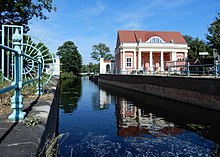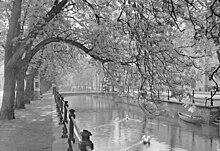City Canal (Potsdam)

The city canal is a historic waterway in Potsdam . Created in 1673 as a drainage ditch to the Havel , the Prussian King Friedrich Wilhelm I had it expanded from 1722 based on the model of Dutch canals . After the filling in between 1962 and 1965, the city canal has been gradually reconstructed since 1999 .
history

The first drainage ditches were built in Potsdam at the end of the 12th century. In 1673, Elector Friedrich Wilhelm dug a new moat. It served to drain the building land for the building projects of the Great Elector in Potsdam. He raised Potsdam to his second residence in 1660 and was now planning the construction of the Potsdam City Palace with the pleasure garden and the first extensions to the city, which at that time had just 200 houses. This electoral moat delimited the northern city and connected the Havel with the Faulen See at the site of the later Wilhelmplatz (today: Platz der Einheit ).
From 1722 the electoral moat was straightened and deepened on behalf of Friedrich Wilhelm I. Following the example of Dutch canals, it was supposed to dry out the building land for the first large-scale baroque city expansion of Potsdam. The canal bed was provided with oak cladding. The wooden bridges received retractable folding structures. This meant that the canal could also be used as a transport route and proved to be extremely useful for embarking the building materials required for the extensive construction work required to build the new district. The basin area was also drained in this way.
The son and successor of Friedrich Wilhelm I, Friedrich the Great , artistically upgraded the canal and had sandstone cladding and artistic iron railings as well as nine stone bridges built. The management of the renovation work on the canal was incumbent on the chief building officer Heinrich Ludwig Manger , who also reports on the work himself: “The canal running through the city was clad with bare boards on both sides, or boarded, and every now and then there were boards on the same cultivated. All of this was very dilapidated and looked bad. The King [Frederick the Great] therefore ordered them to be revetiren [to restore] with sandstone, to provide iron railings, and to vault the bridge over it with sandstone. "
As early as 1809, residents complained about the bad smell and asked for the city canal to be filled in. Parts of the tributaries were filled in as early as 1889.
After the destruction in World War II , the renovation of the city canal and bridges began. In 1952 the sandstones and platforms of the canal were renewed and the bridge figures were restored. In connection with the redesign of the Potsdam center, however, the Potsdam City Council decided in 1962 to fill the canal, which was then carried out until 1965. The last bridge, the "Breite Brücke", was demolished in 1971.
course
The city canal was fed by the Havel and ran through the Potsdam city center for a total length of 1840 meters. It began in the east at the “ cellar gate ” and continued in a westerly direction with the streets “Am Kanal” (“Yorckstrasse”). At the end of Yorckstraße at “Waisenstraße” (“Dortustraße”) it bent in a tight curve, almost at right angles, to the south and flowed back into the Havel at the “Wassertor”.
It was not until the appointment of Potsdam as its second residential city next to Berlin by Elector Friedrich Wilhelm, the Great Elector, in 1660 that the city began to flourish and expand. Friedrich Wilhelm had Philip de Chiese build a city palace based on Dutch models. Between the castle and the banks of the Havel, he laid out a pleasure garden based on the Dutch pattern in a chessboard system and began with the first expansion of the city. As a prerequisite for the redesign and expansion, the elector had the muddy Landwehr ditch from the 16th century cleaned and straightened in its further course in 1675. The course of this "electoral moat" can be traced on the map by Samuel Suchodolec from 1683.
bridges
A total of nine bridges crossed the canal:
- Cellar Gate Bridge (in the extension of Heilig-Geist-Straße)
- Berliner Brücke (Berliner Strasse / Am Canal)
- Green Bridge (French Street / Grünstraße / Am Kanal)
- Kaiserbrücke (Kaiserstraße / Am Kanal)
- Nauener Brücke (Friedrich-Ebert-Straße (formerly Nauener Straße) / Yorckstraße (formerly Am Kanal))
- Ladenbergsteg (Wilhelm-Staab-Straße (formerly Hoditzstraße) / Yorckstraße (formerly Am Kanal))
- Waisenbrücke (Dortustraße (formerly Waisenstraße) / Yorckstraße (formerly Am Kanal))
- Wide bridge (wide street)
- Kiezbrücke (Am Wassertor - Wall am Kiez / Am Lustgartenwall)
Restoration

After the first symbolic work to uncover the city canal was started in 1990 by committed Potsdam residents, the city has also been involved since 1999. At that time, a first section in the area of Yorckstrasse was restored. The inauguration of the rebuilt Ladenbergbrücke took place in 2001 on the occasion of the Potsdam Federal Garden Show . However, the section is mostly dry - there is no connection to the Havel.
Since then, an annual canoe canal sprint has been held on the exposed but only temporarily flooded section of the canal on Yorckstrasse, which has become a popular sporting spectacle in Potsdam.
In March 2009, construction work began on the second section, in the area of the cellar gate bridge, and in July 2011 this could then be reconnected with the Havel. It has flooded since then. The association for the reconstruction of the historic canal has been campaigning for funding since 2015 to further uncover this easternmost section by a further 170 meters, up to Berliner Straße .
The long-term plan is the complete restoration of the entire canal. It is partly financed by donations. There are opportunities to symbolically “acquire” the cast iron railing posts and, like Loriot , Christian Thielemann and others, to have them provided with your own name. The building association Potsdamer Stadtkanal 1722 eV is also trying to restore the canal.
Since Mayor Mike Schubert took office in 2018, the city of Potsdam intends to intensify its efforts to restore the canal. The aim is to encourage the citizens of Potsdam to participate more. In February 2020, SAP co- founder and patron Hasso Plattner announced his support for the reconstruction of the city canal.
See also
Web links
- The Potsdam city canal
- Construction work in the Yorckstrasse / Wilhelm-Staab-Strasse area in July 2009 (PDF file; 1.61 MB)
- It flows again in the city canal
- The pillar donated by Loriot
- Florian Müller-Klug: The City Canal in Potsdam - The Royal Canal . In: Clio Berlin Blog
Individual evidence
- ^ Albrecht Gülzow / Peter Herrmann, Der Potsdamer Stadtkanal, Potsdam 1997, p. 7.
- ^ Heinrich Ludewig Manger, Building History of Potsdam, Vol. 1–3, Berlin 1789, p. 218.
- ↑ Thousands of viewers celebrate Olympic aces in Potsdam maz-online.de on September 4th, 2016
- ^ New shopping mile under the city canal canceled MAZ, June 17, 2015
- ^ Association for the Restoration of the City Canal in Potsdam eV
- ^ New association for city canal in Potsdam MAZ, May 25, 2016
- ↑ Schubert's vision for a new old city sewer PNN, January 27, 2019
- ↑ https://www.pnn.de/potsdam/museum-barberini-freude-ueber-plattners-plaene-in-potsdam/25571838.html
Coordinates: 52 ° 23 ′ 50 ″ N , 13 ° 3 ′ 27 ″ E




